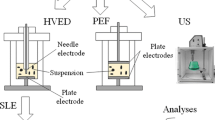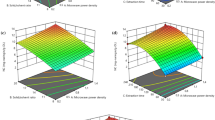Abstract
The main objective of this study is to compare the extraction efficiency, phenolic composition and antioxidant activity of fallen red leaves of the tropical almond (Terminalia catappa) using two extraction methods. The leaf was extracted under different conditions: soaking (12 and 24 h) and pulse electric fields (0.5 and 0.75 kV/cm). The results demonstrated that the highest total phenolic content (TPC) and higher antioxidant activity were related to the 50% concentration of red leaf extract. The evaluation of the two extraction methods revealed that the extract of red leaf obtained via PEF with 0.75 kV/cm field strength had the highest TPC and antioxidant activity (DPPH). Finally, red leaf phenolic compounds were identified and reported by HPLC.



Similar content being viewed by others
References
Adeyemi AO, Oluwasegun AD (2019) Antibacterial activity of aqueous extract of Momordica charantia and Terminalia catappa on multidrug resistant invasive Escherichia coli isolated in ready-to-eat (RTE) foods from ekiti state. Biolo Sci-PJSIR 62:183–187
Anand AV, Divya N, Kotti PP (2015) An updated review of Terminalia catappa. Pharmacogn Rev 9:93
Chyau C-C, Ko P-T, Mau J-L (2006) Antioxidant properties of aqueous extracts from Terminalia catappa leaves. LWT Food Sci Technol 39:1099–1108
Erhabor C, Erhabor J, McGaw L (2019) The potential of South African medicinal plants against microbial biofilm and quorum sensing of foodborne pathogens: a review. S Afr J Bot 126:214–231. https://doi.org/10.1016/j.sajb.2019.07.024
Falleh H, Ksouri R, Lucchessi M-E, Abdelly C, Magné C (2012) Ultrasound-assisted extraction: effect of extraction time and solvent power on the levels of polyphenols and antioxidant activity of Mesembryanthemum edule L Aizoaceae shoots. Trop J Pharm Res 11:243–249
Ghaderi GM, Mamashloo S, Sadeghi MA, Alami M (2011) Evaluation of antioxidant activity, reducing power and free radical scavenging of different extract of Artemisia annua L. J Plant Environ Physiol 6:46–57
Jagessar R, Alleyne R (2011) Antimicrobial potency of the aqueous extract of leaves of Terminalia catappa. Acad Res Int 1:362
Lata B, Trampczynska A, Paczesna J (2009) Cultivar variation in apple peel and whole fruit phenolic composition. Sci Hortic 121(2):176–181
Li J-w, Ding S-d, Ding X-l (2005) Comparison of antioxidant capacities of extracts from five cultivars of Chinese jujube. Process Biochem 40:3607–3613
Lorenzo JM et al (2018) Berries extracts as natural antioxidants in meat products: a review. Food Res Int 106:1095–1104
Manach C, Scalbert A, Morand C, Rémésy C, Jiménez L (2004) Polyphenols: food sources and bioavailability. Am J Clin Nutr 79:727–747
Mandloi S, Mishra R, Verma R, Mugal S, Rajshree S (2013) Phytochemical analysis of the leaf extract of Terminalia catappa L. Indian J Appl Pure Biol 28:65–70
Moghaddam M, Mehdizadeh L (2017) Chemistry of essential oils and factors influencing their constituents. In: Soft chemistry and food fermentation. Elsevier, pp 379–419. https://doi.org/10.1016/B978-0-12-811412-4.00013-8
Mojerlou Z, Elhamirad A, Kenari RE (2017) Comparing antioxidant activity of ethanolic olive cake extract with some synthetic antioxidants on oxidative stability of soybean oil. Int J Pharma Analy Acta 1(1):9–12
Pérez-Ramírez IF, Castaño-Tostado E, Ramírez-de León JA, Rocha-Guzmán NE, Reynoso-Camacho R (2015) Effect of stevia and citric acid on the stability of phenolic compounds and in vitro antioxidant and antidiabetic capacity of a roselle (Hibiscus sabdariffa L.) beverage. Food Chem 172:885–892
Poongulali S, Sundararaman M (2016) Antimycobacterial, anticandidal and antioxidant properties of Terminalia catappa and analysis of their bioactive chemicals. Int J Pharmacy Biol Sci 6:69–83
Sahreen S, Khan MR, Khan RA (2010) Evaluation of antioxidant activities of various solvent extracts of Carissa opaca fruits. Food Chem 122:1205–1211
Sarwar S, Khatun A, Nahar K, Rahman MA (2016) Phytochemical screening, cytotoxic and anthelmintic activities of the methanolic leaf extract of Terminalia catappa Linn. J Pharmacogn Phytochem 5:24
Shalmashi A, Golmohammad F, Bashiri Sadr Z (2017) Multi-satge solvent extraction of soybean isoflavones. Innov Food Technol 4:93–107. https://doi.org/10.22104/jift.2017.2047.1462
Shirmohammadi M, Zarringhalami S (2017) Effect of extraction method and ultrasound on extraction efficiency and bioactive compounds of ethanolic flaxseed powder extract. Iran J Food Sci Technol 14:11–18
Su M-S, Chien P-J (2007) Antioxidant activity, anthocyanins, and phenolics of rabbiteye blueberry (Vaccinium ashei) fluid products as affected by fermentation. Food Chem 104:182–187
Sun L, Zhang J, Lu X, Zhang L, Zhang Y (2011) Evaluation to the antioxidant activity of total flavonoids extract from persimmon (Diospyros kaki L.) leaves. Food Chem Toxicol 49:2689–2696
Wojcik M, Burzynska-Pedziwiatr I, Wozniak L (2010) A review of natural and synthetic antioxidants important for health and longevity. Curr Med Chem 17:3262–3288
Author information
Authors and Affiliations
Corresponding author
Ethics declarations
Conflict of interest
On behalf of all authors, I (the corresponding author) state that there is no conflict of interest.
Additional information
Publisher's Note
Springer Nature remains neutral with regard to jurisdictional claims in published maps and institutional affiliations.
Rights and permissions
About this article
Cite this article
Moghaddam, T.N., Elhamirad, A.H., Saeidi Asl, M.R. et al. Pulsed electric field-assisted extraction of phenolic antioxidants from tropical almond red leaves. Chem. Pap. 74, 3957–3961 (2020). https://doi.org/10.1007/s11696-020-01153-x
Received:
Accepted:
Published:
Issue Date:
DOI: https://doi.org/10.1007/s11696-020-01153-x




